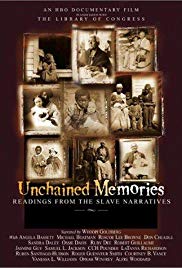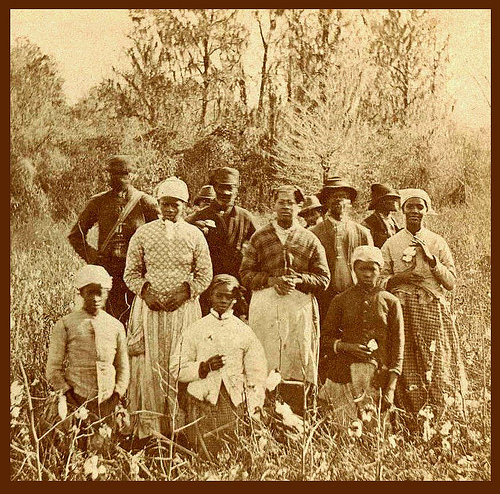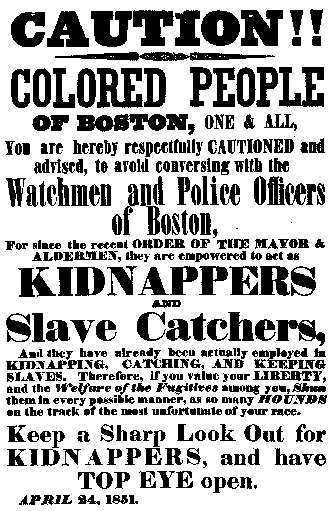The purpose of this assignment is to highlight important points in the student handout Slavery: A World-Wide View, Then and Now by requiring students to paraphrase the information in the handout. The questions reach only Bloom’s Taxonomy levels for “Knowledge” and “Comprehension”. They reach Level One in Art Costa’s three levels of intellectual functioning.
Click Here for a version of this homework assignment, without suggested responses, suitable to be handed out to the class.
Before distributing this homework, tell students that the assignment is open book and that in framing their responses, they should refer to the handout. However, students should answer in their own words and not simply quote the book. Make sure the class understands the definition of irony or modify Question #8.
1. Two reservoirs of slavery have been identified and one other probable reservoir has been discussed by historians. Describe the geographic location of these pools of people, the periods of time during which they existed, and the types of people who were enslaved.
Suggested Response:
The oldest identified slave reservoir consisted of the Slavs of Eastern Europe and Iranians in the provinces of Persia close to Europe. From antiquity to the 19th century, slavers would raid these populations and carry off captives. The black people of sub-Saharan Africa constituted another slave reservoir which provided slaves for the Middle East and later for the Americas. This slave reservoir lasted from the beginning of the Christian Era to the mid-20th century. A third possible population reservoir for slavers consisted of the peoples of Europe (Germanic tribes, Celtic tribes and others) who lived north of the Roman Empire. These people were victims of repeated raids by the Vikings until the early 11th century.
2. What is the origin of the word “slave”?
Suggested Response:
It comes from the word “Slav” and originated in Moorish Spain in the Middle Ages because, for centuries, so many of their slaves had been of Slavic origin. From there the word spread to Europe.
3. Which of the ancient civilizations that have formed the basis for modern Western culture practiced slavery at one time or another? Name at least two.
Suggested Response:
Virtually all civilizations which were precursors for modern Western civilization practiced slavery. Examples include: Greece, Rome, Israel, and Babylon. But most cultures throughout the world have practiced slavery.
4. How extensive was slavery in Africa before the Europeans started the Transatlantic slave trade? Who were the slavers and who were the enslaved?
Suggested Response:
Slavery was practiced virtually everywhere in Africa. The enslaved were black Africans and the masters were black Africans. Arab slave traders also carried blacks out of Africa to slavery in the Middle East and other locations.
5. What is “pawnship” and in what geographic area is it practiced?
Suggested Response:
Pawnship is the bondage of girls to work off a debt that one family owes to another. It is practiced in Africa.
6. What is “compensation marriage” and on which continent is it practiced?
Suggested Response:
Compensation marriage forces girls into arranged marriages as compensation for a murder perpetrated by a member of her family, to offset debts, or to settle other inter-clan or family disputes. Compensation marriage is prevalent in Northwest Pakistan, Afghanistan, and parts of the Middle East.
7. The local African slave trade in the 18th and early 19th centuries was complementary to the Transatlantic slave trade in one respect. Describe this.
Suggested Response:
African slave owners favored women and children. Women and children were less likely to escape and the women could produce children for the slave owner. Adult male captives were more troublesome and dangerous. In the local African slave trade, males were often killed upon capture. The Transatlantic slave trade gave slavers a market for their excess male captives.
8. The handout lists five ironic situations in the history of slavery. (In history, an ironic situation is one in which the facts are opposite from, or at least very different from, what we expect.) Briefly describe the ironic fact referred to in the handout that has to do with the creation of the United States and one other ironic fact shown by the history of slavery. For each situation, explain why it is ironic.
Suggested Response:
The five ironic facts described in the handout and the reasons they are ironic are:
(1) The Transatlantic slave trade saved the lives of some male African captives. Local African slavery favored women and children, with male captives usually being killed. The Transatlantic slave trade gave slavers a market for their male slaves thereby saving the lives of many men who otherwise would have been killed. It is unexpected and ironic that the Transatlantic slave trade, which resulted in bondage and death for millions, actually saved some lives.
(2) The “One-Drop” Rule. Although prejudiced whites considered themselves genetically superior to blacks, they believed that one drop of black blood in a person’s ancestors made the person black. One would have thought that the “superior” “white” genes would be stronger than the “inferior” “black” genes. However, ironically, the “one-drop” rule contradicts this.
(3) Colonialism led to freedom for some colonized people. Colonialism is an oppressive system which resulted in the subjugation of millions for the benefit of the colonizers. However, in the 19th century, outright slavery was banned by most colonial powers. Being free, even under a repressive colonial regime, was better for slaves than being held in bondage. The irony is that colonialism, usually thought of as oppressive, actually resulted in freedom for slaves.
(4) In 1776 an important reason among Southern patriots to support the American Revolution was to preserve slavery. An important factor in motivating many Southern colonists to join the American Revolution was their belief that England would eventually abolish slavery in the colonies. One of the major compromises of 1776, which permitted the colonists to band together to rebel against the British Empire, was the agreement by the Northern colonists to allow slavery to continue in the South. This bargain was later enshrined in the U.S. Constitution, which protected slavery. It was only in 1865, after the bloodiest war in U.S. history, that slavery was abolished in the United States. The unexpected result, the irony, is that the U.S., in many other ways a beacon of freedom for billions of people throughout the world, was built on a compromise that included allowing men, women and children to be enslaved for life.
(5) Liberia, a country established as a place to send liberated American slaves was one of the last countries in the world to outlaw slavery. You would expect that Liberia would be one of the first countries to liberate its slaves. In fact, ironically, it was one of the last.
9. What is the range of estimates about how many slaves exist in the modern world?
Suggested Response:
12 to 27 million.
10. Why are arranged marriages considered by many to be a form of slavery for women?
Suggested Response:
Women don’t get to choose their husbands and are required to submit sexually, bear children, and perform domestic work.
11. Name four forms of modern-day slavery other than compensation marriage and arranged marriage.
Suggested Response:
The forms of modern slavery include: illegal bonded labor, debt slavery, child labor, child prostitution, child pornography, use of children in armed conflicts, and the forced donation of organs of the body.
12. What is human trafficking?
Suggested Response:
Taking people from one country to another for the purpose of having them work in slave-like conditions.
13. How many people did the U.S. State Department estimate were the victims of human trafficking in 2007?
Suggested Response:
800,000.
14. Describe some of the work that people trafficked into the United States perform.
Suggested Response:
Examples are: making garments in sweatshops, prostitution, domestic servitude, and construction.
15. Identify three trends which foster slave labor in the modern world.
Suggested Response:
1) increased population, primarily in the developing world; 2) rapid social and economic change that has caused many people to move to cities and their outskirts, where people have no “safety net” and no job security; and 3) government corruption which allows slavery to go unpunished, even though it is illegal everywhere.









